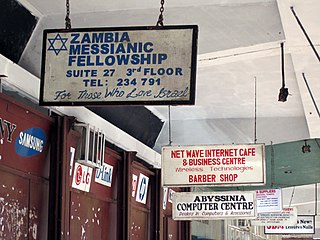Related Research Articles

Western Province is one of the 10 provinces in Zambia and encompasses most of the area formerly known as Barotseland. The capital is Mongu, and together with the neighbouring town of Limulunga, Mongu is treated as the capital of Barotseland.

Kafue National Park is the largest national park in Zambia, covering an area of about 22,400 km2. It is the second largest national park in Africa and is home to 152 different species of mammals. There are also 515 bird species, 70 reptile species, 58 species of fish and 36 amphibious species.
Kabompo is a town in north-western Zambia, lying on the Kabompo River with a population over 88,000 people. It is surrounded by teak forest and is home to a Roman Catholic mission. Kabompo was founded in the 1900s or even earlier than that, the district centre was first situated in Nkulwashi before it was moved to its current location. The district boasts of its significance towards its contribution to the nation's food security through Food Reserve Agency (FRA). Even in the late 60's and early 70's Kabompo was very active in agricultural activities through NAMBOARD.
Kaoma is a town in Zambia. It is the headquarters of Kaoma District in the Western Province and is located on the M9 Road.

Zambia has several major indigenous languages, all members of the Bantu family, as well as Khwedam, Zambian Sign Language, several immigrant languages and the pidgins Settla and Fanagalo. English is the official language and the major language of business and education.
Namwanga or Nyamwanga are a Bantu ethnic group native to Momba District in Songwe Region of Tanzania, northeastern Zambia,and Northern Malawi. They speak Nyamwanga or Chinamwanga. In 1993 the Mwanga population was estimated to number 256,000, with 169,000 living in Zambia and 87,000 in Tanzania. At this point, the number of Namwanga people in Malawi is not yet known.
The Nkoya people are a Bantu people native to Zambia, living mostly in the Western and Southern provinces and the Mankoya area. As of 2006, they were estimated to number 146,000 people. Besides Nkoya proper, Nkoya dialects include Ba Mbowela, Ba Lushange, Ba Lukolwe, Mashasha.
Reuben Chitandika Kamanga was a Zambian freedom fighter, politician and statesman. He was educated at Munali Secondary School.
Kahare was a Nkoya kingdom in what is today Kasempa District, Zambia.
Mutondo was a Nkoya kingdom in what is today Kaoma District, Zambia.
Kabulwebulwe was a Nkoya kingdom in what is today Mumbwa District, Zambia.
Nkoya is a Bantu language of Zambia. It may be one of the Luba languages, and is at least Luban.
Shasha or Sha Sha may refer to:

Momba Station is a pastoral lease that operates as a sheep station in New South Wales. The property is situated approximately 42 kilometres (26 mi) south east of White Cliffs and 66 kilometres (41 mi) north east of Wilcannia.

Momba District is a district of Songwe Region, Tanzania. It is bordered to the north by Lake Rukwa, to the south by Zambia, to the east by the Mbozi District, and to the west by the Rukwa Region. It was formed from the western part of Mbozi District when Songwe Region was created from Mbeya Region.
Momba may refer to:

Songwe Region is one of Tanzania's 31 administrative regions. The region covers a land area of 27,656 km2 (10,678 sq mi). The region is comparable in size to the combined land area of the nation state of Haiti. Songwe Region borders the countries of Zambia and Malawi to the south: Tunduma is the main entry point into Zambia while Isongole is the main entry point into Malawi. Songwe also borders the Tanzanian regions of Rukwa and Katavi in the west, Tabora in the north, and Mbeya in the east. Lake Rukwa is a major body of water in the western part of the region. The region was created on 29 January 2016 from the western half of Mbeya Region. The regional capital is Vwawa. According to the 2022 national census, the region had a population of 1,344,687.